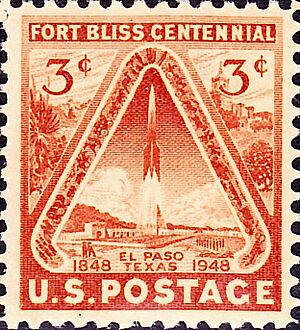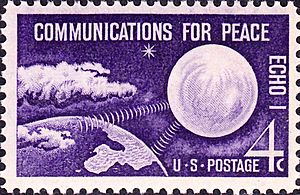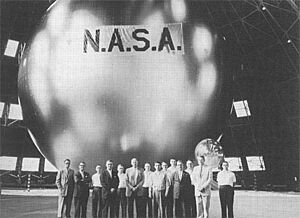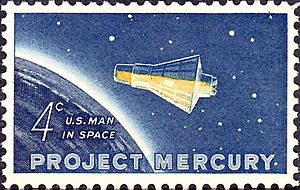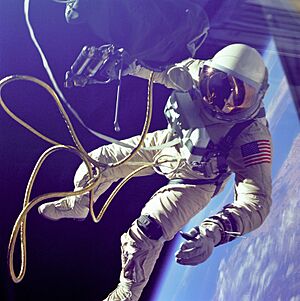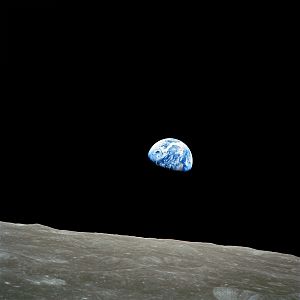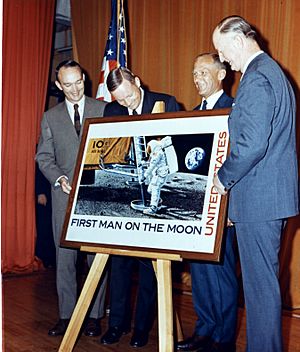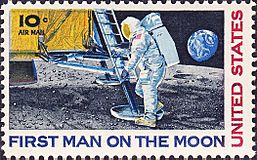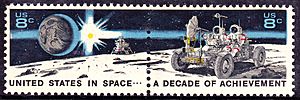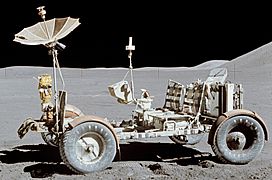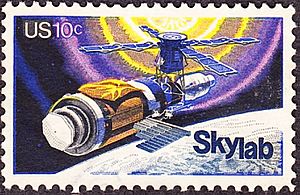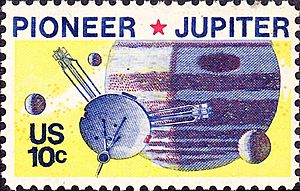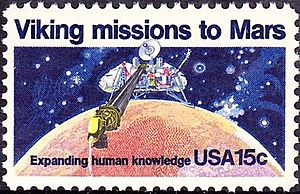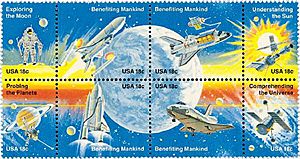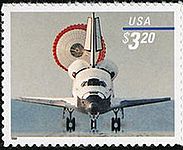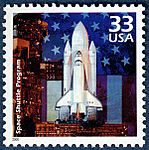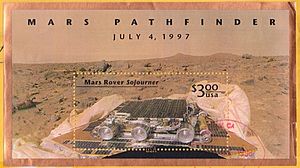U.S. space exploration history on U.S. stamps facts for kids
When humans started exploring space with robots and astronauts, it opened a new chapter in American history. To celebrate these amazing achievements, the U.S. Post Office began putting space-related events on postage stamps. The very first U.S. stamp to show a space vehicle was the Fort Bliss issue in 1948. Later, in 1960, the ECHO I stamp was the first to name a specific space project. The Project Mercury stamp followed in 1962. As space exploration grew, many more stamps were made. These stamps often showed satellites, space capsules, lunar modules, spacesuits, and other cool space items.
People really loved space exploration history. This was clear from how many "First Day of Issue" stamps were sold for space themes. For example, the Project Mercury stamp in 1962 had over three million cancellations on its first day. Other stamps usually only had about half a million. This shows how excited people were about space!
Contents
- Early Space Stamps: Fort Bliss and Echo I
- Project Mercury: Sending Humans to Space (1962)
- Honoring Space Pioneers and Achievements
- Robert H. Goddard: Father of Rocketry (1964)
- Accomplishments in Space: The First American Spacewalk (1967)
- Apollo 8: Seeing Earth from the Moon (1969)
- First Man on the Moon (1969)
- Space Achievement Decade (1971)
- Skylab: America's First Space Station (1974)
- Pioneer and Mariner: Exploring Our Solar System (1975)
- Apollo-Soyuz: Space Cooperation (1975)
- Viking Missions to Mars (1978)
- Later Space Exploration Stamps
Early Space Stamps: Fort Bliss and Echo I
Fort Bliss: A Rocket on a Stamp (1948)
Fort Bliss has a long and interesting history. After World War II, many scientists from Germany came to Fort Bliss in Texas. They helped the U.S. develop rockets, using their knowledge of the V-2 rocket. This work was very important for creating the powerful rockets that later carried satellites and astronauts into space.
The Fort Bliss stamp was released on November 5, 1948, to celebrate the fort's 100th anniversary. It shows what looks like a V-2 rocket. This makes it the first U.S. stamp to feature a space vehicle, even if it was a general design. The stamp was designed by Charles R. Chickering. Over 64 million of these stamps were printed.
Project Echo I: The First Communications Satellite (1960)
On August 12, 1960, NASA successfully launched Echo 1A, often called Echo 1. This was a huge balloon-like satellite, 100 feet wide, made of very thin material. It was used to bounce telephone, radio, and television signals across continents. It also helped scientists study the atmosphere and solar pressure.
Echo 1 was so shiny and big that you could see it with your own eyes from most places on Earth. It was brighter than most stars! Echo 1 was a "passive" satellite, meaning it reflected signals instead of sending them out itself. It was a true pioneer for all future communication satellites. Echo 1 burned up when it re-entered Earth's atmosphere on May 24, 1968.
The U.S. Post Office released the 4-cent Echo I stamp on December 15, 1960. This was the first "Space Stamp" to show an actual space object, unlike the general rocket on the Fort Bliss stamp. It honored the world's first communications satellite. More than 120 million of these stamps were printed.
Project Mercury: Sending Humans to Space (1962)
Project Mercury was the United States' first program to send humans into space. Its main goal was to put an astronaut in orbit around Earth. This goal was achieved on February 20, 1962, with the Mercury-Atlas 6 flight.
The Post Office Department honored this historic flight. They released the Project Mercury stamp on February 20, 1962, at the exact moment Colonel John Glenn's spacecraft safely returned to Earth. The 4-cent stamp shows the Mercury Friendship 7 capsule orbiting Earth, surrounded by stars. This spacecraft is now at the National Air and Space Museum in Washington, D.C.
This stamp was incredibly popular, with over 289 million copies printed. This was more than double the usual number for commemorative stamps at that time. The story behind this stamp is quite interesting. It was printed in secret before the mission happened, just in case the mission failed. The stamps were sealed and marked "Top Secret" at post offices across the U.S. Postmasters were only allowed to open them after Glenn's successful return!
Honoring Space Pioneers and Achievements
Robert H. Goddard: Father of Rocketry (1964)
Robert H. Goddard (1882–1945) is known as the "father of rocketry." He was a brilliant scientist who created the first rocket powered by liquid fuel. He also developed the first rocket to use internal vanes for guidance. He launched his first rocket in March 1926. Goddard's work was revolutionary, but he didn't get much public support during his lifetime. Many people even made fun of his ideas about spaceflight.
Years after his death, when human spaceflight became a reality, Goddard finally received the recognition he deserved. He was seen as the person who truly started modern rocketry and space exploration.
On October 5, 1964, the U.S. Post Office issued a stamp honoring Robert Goddard. It shows him next to a rocket launching from the Kennedy Space Center. His wife, Esther Goddard, attended the ceremony. She even had the honor of pressing a button to launch two rockets, which carried 1,000 "first day covers" for collectors. Over 62 million of these stamps were printed.
Accomplishments in Space: The First American Spacewalk (1967)
The Gemini IV mission in June 1965 was a major step in space exploration. It was the second manned Gemini flight and the tenth manned American flight. The crew included James McDivitt and Ed White.
The most exciting part of this mission was the first spacewalk by an American astronaut, Ed White. He floated outside the spacecraft for 22 minutes, connected by a tether. White used an oxygen-powered "zip gun" to move around. He found it easy to control his movements.
Two 5-cent stamps were released on September 29, 1967, to honor these space achievements. They show an astronaut during a spacewalk. The stamps were designed by Paul Calle, who used photos from the Gemini IV mission. About 120 million of these stamps were printed.
Apollo 8: Seeing Earth from the Moon (1969)
Before Apollo 8, all human space missions stayed close to Earth. But Apollo 8, launched in December 1968, was the first human mission to leave Earth's orbit and travel to the Moon. The three astronauts, Frank Borman, James Lovell, and William Anders, were the first humans to see the far side of the Moon. They were also the first to see Earth from beyond low Earth orbit.
During their orbit around the Moon, the astronauts read parts of the creation story from the Bible. This historic moment was the theme of the Apollo VIII stamp. The stamp shows the famous Earthrise photograph taken by Anders, with the words In the beginning God... printed on it.
This stamp was released in Houston, Texas, on May 5, 1969. Leonard E. Buckley designed it, based on the Earthrise photo and the Genesis reading. Over 187 million of these stamps were printed.
First Man on the Moon (1969)
The Apollo 11 mission made history by landing the first humans on the Moon. Launched on July 16, 1969, the crew included Neil A. Armstrong, Michael Collins, and Edwin E. 'Buzz' Aldrin, Jr. On July 20, Armstrong and Aldrin landed the Lunar Module Eagle on the Moon. They became the first humans to walk on its surface, while Collins orbited above in the Command Module Columbia. This mission achieved President John F. Kennedy's goal of putting a man on the Moon by the end of the 1960s.
On September 9, 1969, the U.S. Post Office issued its first airmail stamp with a space theme: the First Man on the Moon issue. The stamp shows Neil Armstrong taking his first step on the Moon. Paul Calle designed this stamp. The original master die for the stamp was actually flown to the Moon and back! Over 152 million of these popular stamps were printed. Some rare versions are missing the red color, making the flag on Armstrong's arm incomplete.
Space Achievement Decade (1971)
This 'Space Achievements' stamp issue celebrates ten years of space accomplishments. It shows Earth, the Sun, a Lunar Module, the Lunar Roving Vehicle, and astronauts. Two 8-cent stamps were released on August 2, 1971, at Kennedy Space Center, Florida, and Houston, Texas.
Robert T. McCall designed this issue. If you look closely, you can see an accurate picture of the Lunar Rover on the Moon's surface, with the Apollo Lunar Module in the background. About 150 million of these stamp pairs were printed.
Skylab: America's First Space Station (1974)
Skylab was the United States' first space station. It was launched by a Saturn V rocket on May 14, 1973. This 100-ton space station orbited Earth from 1973 to 1979. Astronaut crews visited it three times in 1973 and 1974.
Skylab was a science and engineering laboratory. It was used for many experiments, including detailed X-ray studies of the Sun. The station was active until July 11, 1979, when it fell out of orbit.
The 10-cent Skylab stamp was released on May 14, 1974, celebrating the first anniversary of Skylab's launch. The stamp shows the space station after it was repaired, complete with its "umbrella" sunshade and missing solar panel. Robert T. McCall designed this stamp. Over 140 million were printed.
Pioneer and Mariner: Exploring Our Solar System (1975)
Pioneer: Journey to Jupiter (1975)
In March 1972, NASA launched Pioneer 10 to collect scientific data about Jupiter, the Solar System's largest planet. Pioneer 10 was the fastest human-made object to leave Earth at that time. It was designed to send back information from the Asteroid Belt and Jupiter.
Pioneer 10 became the first spacecraft to get close enough to Jupiter to send back amazing discoveries about the planet. After Pioneer 10, Pioneer 11 was launched on a similar path.
The 10-cent Pioneer stamp was issued on February 28, 1975. Robert T. McCall designed it.
Mariner 10: Visiting Venus and Mercury (1975)
Mariner 10 was launched in November 1973 to explore Venus and Mercury. This mission used Venus's gravity to help it reach Mercury. It also used solar winds to save fuel.
Mariner 10 sent back the first close-up photos of Venus, showing its thick cloud cover. The data helped scientists figure out how fast Venus rotates. Photos of Mercury revealed its cratered surface and huge temperature changes between day and night.
The 10-cent Mariner 10 stamp was issued on April 4, 1975. Roy Gjertson designed it. This stamp and the Pioneer stamp are often grouped together as "U.S. Unmanned Accomplishments in Space." Over 158 million of these stamps were printed.
Apollo-Soyuz: Space Cooperation (1975)
With the Apollo-Soyuz mission in July 1975, two nations worked together on a space project for the first time. The United States' Apollo Command module met up with Russia's Soyuz module in space. A special docking station allowed the astronauts to interact. Television stations around the world showed this historic docking and the astronauts' friendly greeting. The modules stayed connected for two days, and the teams performed many experiments.
The U.S. Postal Service issued two 10-cent stamps for this event on July 15, 1975. Robert T. McCall designed the "after link-up" image, and Anatoly Aksamit designed the "before link-up" image. Over 161 million of these stamp pairs were printed.
Viking Missions to Mars (1978)
NASA's Viking program sent two space probes, Viking I and Viking II, to Mars. Each probe had two main parts: an orbiter to photograph Mars from space, and a lander to study the planet from its surface. The orbiters also helped relay communications from the landers.
If you look closely at the stamp, you can see the details of the lander, including the part that collected soil samples, the radio dish, and landing gear. The U.S. Postal Service released this stamp on July 20, 1978. This was the second anniversary of the Viking I lander touching down on Mars.
Robert T. McCall designed this 15-cent stamp. Over 158 million were printed.
Later Space Exploration Stamps
Space Achievement Issue (1981)
On May 21, 1981, the Post Office released the Space Achievement stamps. These were 18-cent stamps in a block of eight. Four central stamps showed the Space Shuttle in different stages of its mission. This celebrated the first flights of the Space Shuttle and honored twenty years of U.S. human space exploration. The other stamps on the sides honored the Moon walk, Skylab, and Pioneer 11 missions. Robert T. McCall designed these stamps.
Space Shuttle Issues (1995-2000)
The U.S. Space Shuttle stamp of 1995 shows the famous launch of the Space Shuttle Endeavour on June 21, 1993. Phil Jordan designed this stamp.
On June 22, 1995, the USPS released a $3 stamp honoring the Space Shuttle Challenger. Phil Jordan also designed this stamp. For the first time, the Post Office used an actual photograph from a NASA mission instead of an illustration.
On November 19, 1998, an $11.75 Express Mail stamp was issued, showing the Space Shuttle being carried on a special plane. This stamp was also designed by Phil Jordan.
- Other Space Shuttle Issues
Mars Pathfinder (1997)
In November 1997, a $3 Priority Mail stamp was issued to celebrate the achievements of the Mars Pathfinder program. The stamp shows the Sojourner rover on the Pathfinder spacecraft, with a panoramic view of Mars in the background. This design was based on the first image received from Mars Pathfinder after it landed on Mars on July 4, 1997. Information about the Pathfinder mission was printed on the back of the stamp sheet. Fifteen million of these stamps were printed.



